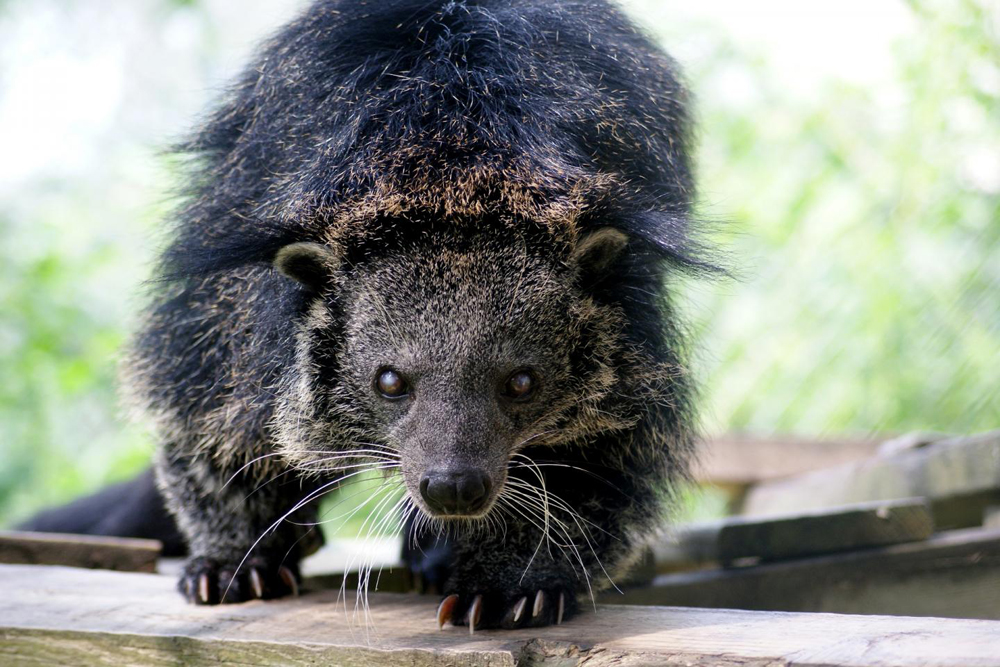Scientists Discover Why Bearcats Smell Like Hot Buttered Popcorn
The civet’s urine shares a “major aroma compound” with a popular cinema snack.
By Vicki Croke
Binturongs are beautiful: They have black or brown hair and long white whiskers. Their faces are catlike, and their bodies are a little bear-like, though they are only two to three feet long (plus a prehensile tail almost as long as their bodies), and the animals weigh 30 to 50 pounds. Photo: Carolina Tiger Rescue.
Binturongs, often confusingly called bearcats, are members of the civet family from Southeast Asia. And people who take care of them in captivity—in zoos and sanctuaries—have often joked and wondered why these animals smell so much like hot buttered popcorn.
Now we know.
Scientists at Duke University analyzed the chemistry of binturong urine and discovered the presence of 2-acetyl-1-pyrroline, or 2-AP. That, according the university’s news release, is “the same compound that gives popcorn its tantalizing scent.”
A sleepy binturong at Khao Yai National Park in Thailand. Video: Chaiyan Kasorndorkbua/YouTube.
Binturongs are fairly solitary rainforest dwellers and if they want to warn trespassing rivals, or attract mates, it’s important for them to leave messages. That’s where that smell comes in: It’s an important element in their sniffable business cards, or “urine smell-o-grams,” as Duke calls them. But scientists wanted to know exactly how it’s produced. According to a statement from Duke:
Previous studies searched for compounds in secretions from the scent glands under the binturong’s tail that could explain its signature scent, but nothing turned up.
In a paper appearing online in the journal The Science of Nature – Naturwissenschaften, researchers analyzed urine samples collected during routine physical examinations of 33 binturongs at Carolina Tiger Rescue, a nonprofit wildlife sanctuary in Pittsboro, North Carolina.
Binturongs pee in a squatting position, soaking their feet and bushy tails in the process. They also drag their tails as they move about in the trees, leaving a scent trail on the branches and leaves behind them.
Using a technique called gas chromatography-mass spectrometry, the researchers identified 29 chemical compounds in the animals’ urine. The one compound that emanated from every sample was 2-acetyl-1-pyrroline, or 2-AP… What’s more, 2-AP was among the few compounds that lingered and became more dominant over time.
With popcorn, toast, and cooked rice, 2-AP forms in a chemical reaction during heating.
So, Christine Drea, a professor of evolutionary anthropology at Duke who led the study, asked: “How does this animal make a cooking smell, but without cooking?”
Binturongs pee in a squatting position, soaking their feet and bushy tails in the process. They also drag their tails as they move about in the trees, leaving a scent trail on the branches and leaves behind them. Photo: Carolina Tiger Rescue.
It probably has something to do with bacteria that the urine touches. Drea explained in the news release, “Bacteria make smelly compounds as they break down sweat in our armpits in much the same way.”
It got us thinking about other animals who surprise us with their scents. Castoreum, the sticky secretion produced by a beaver’s castoreum sacs, located near the base of the tail, makes the rodents smell like vanilla. And lots of people say their dog’s feet smell like Frito corn chips (just Google Frito feet). Earlier research on the latter points to bacteria living on their paws and giving off a different crunchy snack smell.



One Response to “Scientists Discover Why Bearcats Smell Like Hot Buttered Popcorn”
If they ever come up with artificial popcorn, they know where to get the flavoring.
Comments are closed.